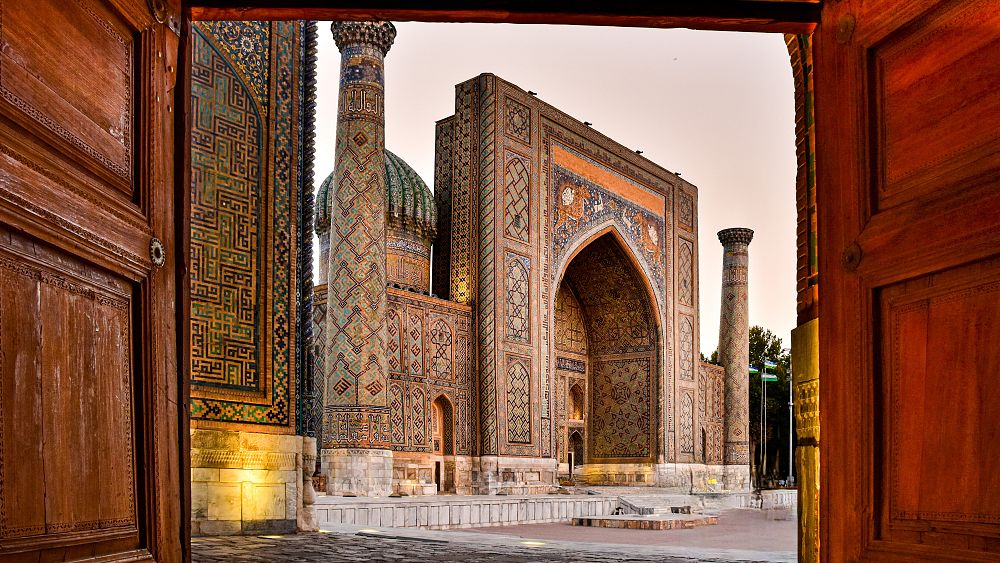
Over the course of 1,500 years, the network of trade routes known as the Silk Road brought together people and cultures from across Asia, shaping the course of history. The diverse landscapes forming the region now known as Uzbekistan formed a crossroads along the route, and its historical legacy remains.
Named for its lucrative trade in silk, the Silk Road traversed several of Uzbekistan’s major cities, including Samarkand, Bukhara and Khiva. These would see the exchange of spices and precious gems as well as silk, but also the interchange of artistic and cultural ideas.
Visitors can glimpse into the past, preserved in the shape of labyrinthine bazaars and ornate architecture, in these cities, but shouldn’t overlook what else makes Uzbekistan unique, from its intricately patterned ceramics and gaily coloured textiles to hearty cuisine; its captivating art museums to the snowcapped ‘heavenly mountains’ of the Tian Shan range.
Samarkand
Few place names are as evocative as Samarkand, also known as the ‘Crossroads of Culture’. The city has an almost mythical quality but the reality is no less impressive, with much to offer the tourist. Begin any visit with a stroll through Registan, an ensemble of madrasas around a central square, their impossibly ornate tiles glinting in the sun.
Other unmissable sights in the city include the Soviet-restored 14th-century Bibi-Khanym mosque complex, one of the largest in the world, and Gur-e-Amir, the emperor Tamerlane’s final resting place, with its landmark blue dome and intricately patterned inner chamber.
More spectacular mausoleums are to be found at the Shah-i-Zinda necropolis, where visitors can wander past a 15th-century hammam and past tombs dating back to the seventh century.
Bukhara
The whole of Bukhara’s historic centre has been recognised by UNESCO as a World Heritage Site. The Kalyon minaret pierces the sky above Bukhara’s labyrinthine alleys, and is said to be the only monument spared by Genghis Khan when his army destroyed everything around it.
The Kalyon mosque is the match of Samarkand’s Bibi-Khanym. As well as the famed minaret and the mosque itself, the complex includes two madrasas, all built between the 12th to the 16th centuries.
At the very centre of Bukhara is the Ark, a vast and ancient fortress, once used for royal residences and now home to history museums and other attractions.
Khiva
The city of Khiva is also famous for a UNESCO-protected fortress town, the Ichan-Kala. This sand-coloured maze of mosques, minarets, ancient houses and museums is ringed by undulating crenellated walls and has a squat, geometrically tiled tower in its central square. Intended as a minaret, the Kalta Minor was never completed.
Everywhere you look in Khiva are reminders of its importance as a trading post on the Silk Road. Among the city’s other attractions are the glittering Paklavon Makhmud mausoleum, named for the 18th-century poet buried here, the elegant Nurullabay Palace and the Kunya-Ark citadel.
Tashkent
Nowhere is the country’s diversity celebrated as it is in the capital, Tashkent, where ancient and modern traditions and architecture sit side by side.
From its vast monuments adorned with intricate tilework to its brutalist Soviet-era buildings, every corner of the city tells a story. As the Silk Road of the past facilitated cultural exchange, today’s Tashkent is a conduit for cross-border commerce, and it blends its rich historical tapestry with a progressive outlook.
Alongside its mosques and madrasas, dating back centuries, are cutting edge museums and exhibition centres. The State Museum of History is a good place to start, for a useful primer on Uzbekistan and its people.
The great outdoors
The alpine meadows, waterfalls and crystalline lakes of the Tian Shan mountain range draw hikers and climbers from across the globe. Its ski resorts are hugely popular in winter, and those same trails are used for horse-riding and walking in summer.
Uzbekistan has a wide variety of landscapes, from deserts to forests, and much of its flora and fauna is protected in natural parks. A dried-up lake might sound unlikely as a tourist destination, but the Aral Sea draws visitors for its peculiar landscape of barren sea bed and rusted ships. The measures taken to replenish the water levels and restore the biodiversity of the area are starting to have some success.
Shopping and eating
Strolling the great bazaars of Samarkand, Tashkent and elsewhere is a magical way to absorb the sights and sounds of the country, but also to appreciate some of its traditions. Look out for handprinted paper, silk rugs, wood carvings and embroidered fabrics. In the Fergana Valley, be sure to pick up some of the blue Rishtan ceramics, and everywhere you go you’ll find the dyed ikat fabrics.
Allow plenty of time for breaks in local chaihanas (tea houses) and to linger over hearty plov (pilau rice) dishes with chargrilled lamb, beef and horse, shashlik kebabs, or spicy lagman noodle soup.